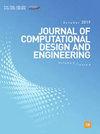Reimagining space layout design through deep reinforcement learning
IF 4.8
2区 工程技术
Q1 COMPUTER SCIENCE, INTERDISCIPLINARY APPLICATIONS
引用次数: 0
Abstract
Space layout design is a critical aspect of architectural design, influencing functionality and aesthetics. The inherent combinatorial nature of layout design poses challenges for traditional planning approaches; thus, it demands the exploration of novel methods. This paper presents a novel framework that leverages the potential of deep reinforcement learning (RL) algorithms to optimize space layouts. RL has demonstrated remarkable success in addressing complex decision-making problems, yet its application in the design process remains relatively unexplored. We argue that RL is particularly well-suited for the design process due to its ability to accommodate offline tasks and seamless integration with existing CAD software, effectively acting as a simulator for design exploration. Framing space layout design as an RL problem and employing RL methods allows for the automated exploration of the expansive design space, thereby enhancing the discovery of innovative solutions. This paper also elucidates the synergy between the design process and the RL problem, which opens new avenues for exploring the potential of RL algorithms in design. We aim to foster experimentation and collaboration within the RL and architecture communities. To facilitate our research, we have developed SpaceLayoutGym, an environment specifically designed for space layout design tasks. SpaceLayoutGym serves as a customizable environment that encapsulates the essential elements of the layout design process within an RL framework. To showcase the effectiveness of SpaceLayoutGym and the capabilities of RL as an artificial space layout designer, we employ the PPO algorithm to train the RL agent in selected design scenarios with both geometrical constraints and topological objectives. The study further extends to contrast the effectiveness of PPO agents with that of genetic algorithms, and also includes a comparative analysis with existing layouts. Our results demonstrate the potential of RL to optimize space layouts, offering a promising direction for the future of AI-aided design.通过深度强化学习重塑空间布局设计
空间布局设计是建筑设计的一个重要方面,对功能和美学都有影响。布局设计固有的组合性质给传统的规划方法带来了挑战,因此需要探索新的方法。本文提出了一个新颖的框架,利用深度强化学习(RL)算法的潜力来优化空间布局。强化学习在解决复杂的决策问题方面取得了显著的成功,但其在设计过程中的应用仍相对欠缺。我们认为,由于 RL 能够适应离线任务,并能与现有的 CAD 软件无缝集成,因此特别适合设计过程,可有效充当设计探索的模拟器。将空间布局设计作为一个 RL 问题并采用 RL 方法,可以自动探索广阔的设计空间,从而促进创新解决方案的发现。本文还阐明了设计过程与 RL 问题之间的协同作用,为探索 RL 算法在设计中的潜力开辟了新途径。我们的目标是促进 RL 和建筑界的实验与合作。为了促进我们的研究,我们开发了专门用于空间布局设计任务的环境 SpaceLayoutGym。SpaceLayoutGym 是一个可定制的环境,它将布局设计过程的基本要素封装在 RL 框架内。为了展示 SpaceLayoutGym 的有效性以及 RL 作为人工空间布局设计师的能力,我们采用 PPO 算法在选定的设计场景中训练 RL 代理,这些场景既有几何约束,也有拓扑目标。研究进一步扩展,对比了 PPO 代理与遗传算法的有效性,还包括与现有布局的对比分析。我们的研究结果证明了 RL 在优化空间布局方面的潜力,为未来的人工智能辅助设计提供了一个前景广阔的方向。
本文章由计算机程序翻译,如有差异,请以英文原文为准。
求助全文
约1分钟内获得全文
求助全文
来源期刊

Journal of Computational Design and Engineering
Computer Science-Human-Computer Interaction
CiteScore
7.70
自引率
20.40%
发文量
125
期刊介绍:
Journal of Computational Design and Engineering is an international journal that aims to provide academia and industry with a venue for rapid publication of research papers reporting innovative computational methods and applications to achieve a major breakthrough, practical improvements, and bold new research directions within a wide range of design and engineering:
• Theory and its progress in computational advancement for design and engineering
• Development of computational framework to support large scale design and engineering
• Interaction issues among human, designed artifacts, and systems
• Knowledge-intensive technologies for intelligent and sustainable systems
• Emerging technology and convergence of technology fields presented with convincing design examples
• Educational issues for academia, practitioners, and future generation
• Proposal on new research directions as well as survey and retrospectives on mature field.
 求助内容:
求助内容: 应助结果提醒方式:
应助结果提醒方式:


